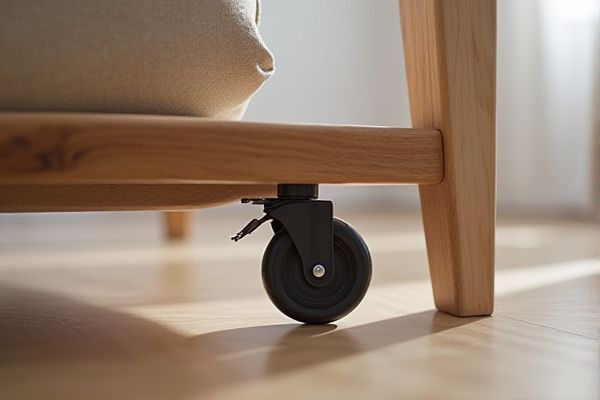
Caster wheels offer superior mobility, allowing furniture or equipment to move smoothly across various surfaces, while glides provide stability and prevent scratching by remaining stationary. Discover which option best suits Your needs by exploring the detailed comparison in the rest of this article.
Table of Comparison
| Feature | Caster Wheels | Glides |
|---|---|---|
| Mobility | High mobility; easy movement on various surfaces | Static; designed to keep furniture in place |
| Surface Compatibility | Works well on carpet, hardwood, and tile | Best on hardwood and smooth floors |
| Weight Capacity | Generally supports heavier loads | Supports moderate to heavy loads, depending on design |
| Installation | Requires mounting with screws or bolts | Usually screwed or glued in place |
| Noise | Can produce noise during movement | Quiet, no movement noise |
| Floor Protection | May cause scratches; soft wheels mitigate damage | Generally gentle; prevents floor damage |
| Typical Use | Office chairs, carts, mobile furniture | Stationary furniture, sofas, cabinets |
Introduction to Caster Wheels and Glides
Caster wheels provide smooth mobility and are designed to roll easily over various surfaces, commonly used in office chairs, carts, and industrial equipment. Glides, on the other hand, offer stationary support with a fixed base that protects floors while allowing chairs or furniture to slide gently without rolling. Both components are essential in furniture design, optimizing movement and floor protection based on the specific application needs.
Key Differences Between Casters and Glides
Casters feature rotating wheels that allow for smooth, multidirectional movement, making them ideal for furniture or equipment that requires frequent repositioning. Glides have fixed, stationary pads designed to protect floors and provide stability without mobility, perfect for items that remain largely in place. Choosing between your furniture casters or glides depends on whether you prioritize mobility or static support on various floor surfaces.
Advantages of Caster Wheels
Caster wheels offer superior mobility and ease of movement across various surfaces, making them ideal for heavy furniture and equipment that require frequent repositioning. Their swivel design allows for smooth, multidirectional maneuvering, reducing strain on your body and floors. Compared to glides, caster wheels provide greater versatility and efficiency in dynamic environments where flexibility is essential.
Benefits of Using Glides
Glides provide superior stability and support by maintaining a fixed position, making them ideal for stationary furniture and reducing floor damage. They require less maintenance compared to caster wheels, as they lack moving parts that can wear out or collect debris. Glides also offer a quieter experience by eliminating the noise associated with rolling wheels.
Common Applications: Where Casters Excel
Casters excel in environments requiring frequent mobility, such as industrial settings, office chairs, and medical equipment, providing smooth movement over various surfaces. Their swivel design allows for easy directional changes, making them ideal for tasks involving heavy loads and frequent repositioning. Unlike glides, casters support dynamic applications by reducing effort and increasing efficiency in transport and maneuverability.
Ideal Situations for Glides
Glides are ideal for stationary furniture or equipment that rarely needs to be moved, providing stability and preventing floor damage. Your chair or table with glides will have a firm and steady base, making it perfect for tasks requiring minimal movement. Glides work best on carpeted or uneven surfaces where caster wheels might get stuck or cause wear.
Material and Design Considerations
Caster wheels typically feature polyurethane or rubber materials that provide smooth mobility and shock absorption, making them ideal for heavy loads and uneven surfaces. Glides, often made from nylon, plastic, or metal, prioritize stability and floor protection with flat, stationary designs suitable for lightweight furniture on hard flooring. Your choice depends on balancing maneuverability and surface preservation, considering the specific material properties and intended usage environment.
Durability and Maintenance Comparison
Caster wheels typically offer higher durability due to their robust design and ability to absorb shocks, making them ideal for frequent movement on various surfaces. They require regular cleaning and lubrication to maintain smooth rotation and prevent debris buildup, which can impact performance. Glides, while simpler and often more durable on flat surfaces with less maintenance, may wear down faster on uneven floors and do not provide the same level of mobility, impacting long-term usability.
Cost Analysis: Casters vs. Glides
Caster wheels generally incur higher upfront costs due to their complex construction and durable materials designed for mobility and load capacity, while glides are more budget-friendly with simpler designs suited for stationary furniture. Maintenance expenses for casters can increase overall cost, as they require periodic lubrication and debris removal, whereas glides demand minimal upkeep, primarily replacement when worn. When evaluating total cost of ownership, casters offer enhanced functionality at a premium, whereas glides provide a cost-effective solution for stationary applications with lower long-term expenses.
Choosing the Right Option for Your Needs
Caster wheels offer superior mobility and ease of movement, making them ideal for applications requiring frequent repositioning, such as office chairs or industrial carts. Glides provide greater stability and a fixed position, suitable for furniture that needs to stay firmly in place like dining chairs or desks. Selecting between caster wheels and glides depends on prioritizing either mobility or stationary support based on the specific use case.
 homyna.com
homyna.com